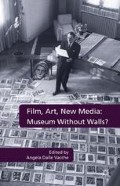Abstract
Originally conceived as an international symposium at the Clark Institute in Williamstown, Massachusetts, during the month of March 2009, the purpose of this anthology is to look at the relation of film studies and art history and to ask: what do these two fields have to offer each other and why? Historically, movement has been both problematic and fascinating for artists and art historians who, in the plastic arts, produce and study mostly static objects. To be sure, the nineteenth-century invention of photography, a medium unconcerned with the human hand, paradoxically both deepened and bridged the gulf between the fine arts and popular media, thanks to the spreading of mechanical reproduction. By adding movement, the turn-of-the-century invention of the cinema combined illusion with the impression of reality, frail shadows with the speed of modern life. As a form of mummified change, or embalmed duration,1 the cinema and the museum have respectively specialized in the perception of time passing and in the display of past traces. The widespread use of digital media in the twenty-first century has brought down the walls of the museum by opening up this eighteenth-century institution to marginalized areas of society. It is perhaps to slow down this new concept of the museum as a database of images accessible anywhere and anytime, that major institutions such as the Louvre, the Hermitage, and the Musée d’Orsay have started producing feature films, asking prominent directors to develop their own views about the space and the mission of the museum.
Access this chapter
Tax calculation will be finalised at checkout
Purchases are for personal use only
Preview
Unable to display preview. Download preview PDF.
Notes
A. Dalle Vacche, “Cinema and Art History: Film Has Two Eyes,” in The SAGE Handbook of Film Studies, ed. J. Donald and M. Renov (London; Thousand Oaks, Calif.: Sage, 2008, pp. 180–98).
B. Peucker, Incorporating Images: Film and the Rival Arts (Princeton, NJ: Princeton University Press, 1995).
L. Manovich, The Language of New Media (Cambridge, MA: MIT Press, 2002).
H. Bergson, Time and Free Will: An Essay on the Immediate Data of Consciousness (New York: Macmillan, 1910).
M. Merleau-Ponty, The Phenomenology of Perception (1945) (New York: Routledge, 2011).
Editor information
Editors and Affiliations
Copyright information
© 2012 Angela Dalle Vacche
About this chapter
Cite this chapter
Vacche, A.D. (2012). Introduction: A Cosmology of Contingency. In: Vacche, A.D. (eds) Film, Art, New Media. Palgrave Macmillan, London. https://doi.org/10.1057/9781137026132_1
Download citation
DOI: https://doi.org/10.1057/9781137026132_1
Publisher Name: Palgrave Macmillan, London
Print ISBN: 978-1-349-32358-6
Online ISBN: 978-1-137-02613-2
eBook Packages: Palgrave Media & Culture CollectionLiterature, Cultural and Media Studies (R0)

